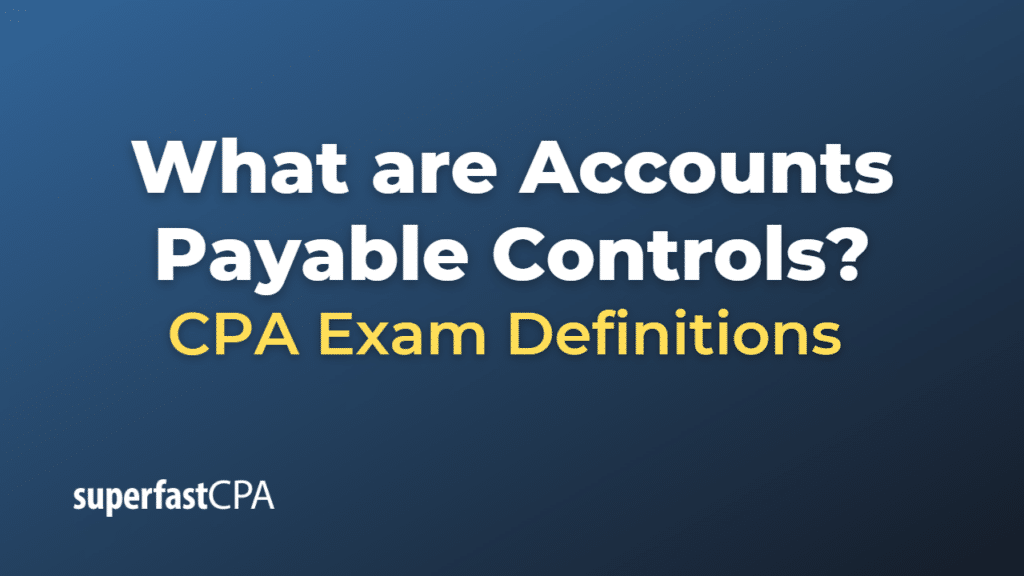Accounts Payable Controls
Accounts payable controls are internal procedures and policies implemented by a company to ensure the accuracy, completeness, and timeliness of its accounts payable transactions. These controls help to prevent errors, fraud, and duplicate payments, and they ensure compliance with regulations and company policies. Effective accounts payable controls contribute to efficient cash flow management, accurate financial reporting, and maintaining good relationships with suppliers.
Some common accounts payable controls include:
- Segregation of duties: Assigning different tasks related to the accounts payable process to different individuals helps prevent fraud and errors. For example, separate employees should be responsible for invoice processing, payment authorization, and bank reconciliations.
- Authorization and approval: Companies should establish clear approval and authorization policies to ensure that only valid and accurate invoices are processed for payment. This may include requiring multiple approvals for large invoices or implementing electronic approval systems.
- Invoice matching: To prevent duplicate payments and ensure the accuracy of transactions, companies should implement a three-way matching process. This involves comparing the purchase order, the invoice, and the goods receipt to verify the quantity, price, and terms before processing a payment.
- Vendor management: Maintain an up-to-date and accurate vendor master file to ensure that payments are made to legitimate suppliers. This may involve regularly reviewing and updating vendor information, performing background checks on new vendors, and implementing controls to prevent unauthorized changes to vendor records.
- Payment controls: Implement controls around the payment process, such as using positive pay (a fraud detection service provided by banks), setting payment limits, and requiring dual signatures or electronic authorization for large payments.
- Reconciliation: Regularly reconcile accounts payable balances with general ledger accounts and supplier statements to ensure the accuracy of financial reporting and identify any discrepancies or errors.
- Monitoring and review: Periodically review accounts payable transactions, processes, and controls to identify potential issues, inefficiencies, or areas for improvement. This may involve conducting internal audits, analyzing accounts payable aging reports, and reviewing payment patterns.
- Documentation and recordkeeping: Maintain accurate and complete records of accounts payable transactions, approvals, and supporting documents. This helps ensure compliance with regulations and company policies and provides an audit trail for future reference.
By implementing and maintaining effective accounts payable controls, a company can reduce the risk of errors, fraud, and non-compliance while improving cash flow management, financial reporting accuracy, and supplier relationships.
Example of Accounts Payable Controls
Let’s consider a fictional company, “Garden Delights Nursery,” which wants to implement accounts payable controls to ensure accuracy, prevent fraud, and improve its cash flow management. Here are some of the controls Garden Delights Nursery might put in place:
- Segregation of duties: Garden Delights Nursery assigns different tasks to different employees. One employee is responsible for receiving and entering invoices, another employee approves payments, and a third employee reconciles bank statements.
- Authorization and approval: The company establishes a policy requiring approval from a department manager for invoices over $1,000 and approval from the finance manager for invoices over $5,000.
- Invoice matching: Garden Delights Nursery implements a three-way matching process that compares purchase orders, invoices, and goods receipts before processing payments. This ensures that the quantity, price, and terms are correct and prevents duplicate payments.
- Vendor management: The company maintains a vendor master file and regularly reviews and updates vendor information. New vendors are subject to background checks, and changes to vendor records can only be made by authorized personnel.
- Payment controls: Garden Delights Nursery uses positive pay services from its bank, sets payment limits on electronic transfers, and requires dual signatures for checks over $10,000.
- Reconciliation: The company’s accounting department reconciles accounts payable balances with general ledger accounts and supplier statements monthly to ensure accurate financial reporting and identify discrepancies.
- Monitoring and review: Garden Delights Nursery conducts internal audits of its accounts payable processes and controls annually. The company also reviews accounts payable aging reports and payment patterns to identify potential issues or areas for improvement.
- Documentation and recordkeeping: The company maintains organized and secure records of accounts payable transactions, approvals, and supporting documents. This ensures compliance with regulations and company policies and provides an audit trail for future reference.
By implementing these accounts payable controls, Garden Delights Nursery can reduce the risk of errors, fraud, and non-compliance while improving cash flow management, financial reporting accuracy, and maintaining good relationships with suppliers.













